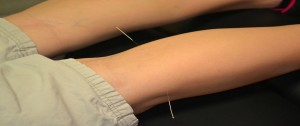Acupuncture: Why use it?
Acupuncture involves the insertion on needles or the stimulation with electrical current/pressure of specific points throughout the body. Acupuncture is about balancing the flow of energy called chi. Chi is our life energy that flows through our bodies and it is affected by the stress that we deal with every day. Acupuncture helps to balance out our chi and the more balanced we are the better and healthier we feel. This is more of an eastern medicine approach to stress and treatment with acupuncture while western medicine views acupuncture as a way to stimulate nerves, muscles and connective tissue. Dry needling is a common use for acupuncture needles in the US. Overall, acupuncture works by stimulating the body’s natural response to injury by increasing blood flow and natural painkillers.
Acupuncture can be performed by using needles, with an electrical or laser stimulation, with a non-puncture needle, or with finger pressure. Needle stimulation is the most powerful form of acupuncture or meridian therapy. Meridian therapy is the actual name of the study of acupuncture, while acupuncture just indicates the use of needles to stimulate the different points of treatment on the meridian. There are 12 pairs of meridians on each side of the body making 24 main meridians in total, along with the Conception and Governor vessels that run along the front and back of the body, along with the center. For ease of description, we will use acupuncture in talking about meridian therapy. The 12 main or Principle meridians are named for different organs in the body that they correlate with and are divided into two groups- the Yin and Yang. The Yin meridians include the Lung, Heart, Pericardium, Spleen, Kidney, and Liver, and the Yang meridians are Large Intestine, Small Intestine, Triple Burner, Stomach, Bladder and Gall Bladder. Each meridian either starts or ends on a hand or foot and transverse the body.
5 ways how acupuncture/Meridian therapy is used in our office:
1. Sciatic pain/Nerve pain
Acupuncture is helpful by reducing the tension and inflammation around the injured and irritated nerve.
2. Bells Palsy/Trigeminal neuralgia
Using different points along the meridians that lie along the face, we have been able to help with bells palsy and reduce the stress to the facial and trigeminal nerves.
3. Trigger points
Trigger points are decreased with the use of placing a needle into the trigger point and physically breaking up part of the muscle fibers that are tightened.
4. Fibromyalgia/Chronic muscle pain
Chronic pain syndromes such as fibromyalgia and myofascial pain syndrome are helped with acupuncture. Relieving stress and inducing relaxation is helpful for any chronic pain.
5. Allergies/Headaches
Allergy relief can usually be felt with the stimulation of the sinus points located in the frontal bone of the forehead or around the eye. Headaches can be helped also with decrease of muscle trigger points.
A Useful Point to know
A useful acupuncture point that you can use at home is Large Intestine 4. LI 4 is helpful for pain of any kind. It is located in the web of each thumb and it can be stimulated for 30 seconds to help alleviate pain.
We hope you enjoyed this overview of what acupuncture may be able to help with but please consult a medical profession before trying any acupuncture on yourself or others. Give our office a call if you have any questions or have a look at our acupuncture page here on the website.

